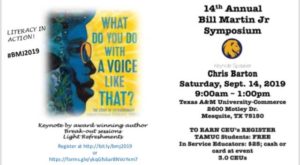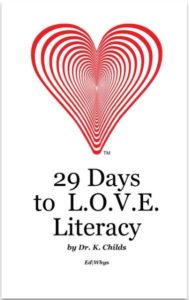While working my graduate studies, I was asked to do a comparative research assignment. This is where you take a current issue, or problem in education, and find a study from many years ago which it compares to. My study compared an educational problem in reading in 2010, and then seen what research was available in 1939 in relation to the same issue. It was very interesting to compare research from these two time periods, as well as it was an informing experience to read the study of an alumnus of the same university (Texas Southern University) which I was attending. The field of education and the university itself has endured many changes, but there were many parallels in our research on reading instruction.
In this post, only the introduction will be shared. To view the rest of the comparative research, a link will be provided after the introduction.
INTRODUCTION
When discussing student attitudes about school, cognitive scientist, Daniel Willingham, states “What has surprised me most has also disheartened me most; it’s the difference in attitude between first graders and sixth graders. First graders are all basically happy to be in school. Sure, they get frustrated or bored by what they’re doing, but when they do, their response is generally “I don’t like this. What else can I do?” They are still game, still ready to go” (Willingham, 2010). Students look forward to going to school in the primary grades. Rarely do you come across a child who wants to voluntarily miss school in Kindergarten through second grade. Many students at this level are given a lot of attention, praise, and have the burning desire to learn at this time in their lives.
Of single most importance at the primary level, are the students learning how to read, and the forming of a literacy background. When walking through the school doors, they don’t know that they are learning basic skills that will stick with them for this rest of their life. Reading should be a skill that will build and follow them through school, follow them into the job market, and assist with everyday tasks such as driving, grocery shopping, and even taking medications. However, there are “…44million U.S. adults who do not have adequate reading skills to fill out a job application, read a food label, or read a story to a child. These individuals often lack the literacy skills needed to find and keep decent jobs, support their children’s education, or participate actively in civic life” (Cooter, 2006). At one point most of those adults attended school, and thought they knew how to read, or were on their way. Our society is fostering generations of people who “…don’t see school as a place of excitement and opportunity. They see school as a place where they fail and are made to feel ashamed” (Willingham, 2010).
“I hate reading” or “Reading is boring” is commonly heard once students reach the upper grades. “We have employed a variety of strategies and incentives, and, like Kohn (1993), we have found that extrinsic rewards were not effective at producing lasting change. Despite our efforts, we still heard negative comments about reading from our students” (Bauserman & Edmunds, 2006). The “…decline in motivation has been attributed to children’s growing awareness of their own performance as compared to others, as well as to instruction that emphasizes competition and does not address children’s interests” (Bauserman & Edmunds, 2006). With high stakes testing, and reforms that are taking education into many stained directions, we are finding that students are becoming “burned out” by the time they reach the upper elementary grades (in this case, fourth through sixth grades). Not only is the manner in which the way the government is handling education stifling student growth, it is hindering teachers as well. “Teachers are losing trust in their professional beliefs and abilities and their instructional creativity when faced with testing pressures” (Assaf, 2006) .
The issues within reading instruction and problem approaches in reading instruction has been a growing issue, and did not just come about with new reforms. The research into this area involves two principal areas. The first is a 1939 study of Teaching Problems in Reading in the Primary Grades as Revealed by Aptitudes of Pupils in Blackshear and Douglas Elementary Schools. The focus is on grades Kindergarten through third, and how modern approaches may positively impact the students and their classroom environment. The second study looks at contemporary literature and best practice and how its ideas parallel the 1939 study. An in depth comparison will be structured concerning both studies.
The following research will compare Pearl James Holland’s 1939 study to a comprehensive review of contemporary literature covering best practice in teaching reading in reference to teaching strategies, classroom environment, content, and specific strategies to use in each grade level in the elementary spectrum. Through analyzing methods used in the past, and present day practice, a course of action to sharpen reading instruction for the future will be presented. The priority for reading instruction in the present should be to provide content that is student-centered and relevant to their everyday lives. Instruction should be differentiated and varied, due to the wide variety of experiences that students bring to the classroom. And lastly, the focus of this research will be to determine that educators should be looking toward keeping student interest in reading in the upper elementary grades by exercising the same enthusiasm, tenaciousness, and attention to details when planning lessons that is seen in the earlier grades.
Click to read the entire comparative research paper: Download
References
Anderson, L. (2009, February). Upper Elementary Grades Bear the Brunt of Accountabilty. Phi Delta Kappan , 414-418.
Assaf, L. (2006). One reading specialist’s response to high-stakes testing pressures. The Reading Teacher , 158-167.
Bartholomew, R., & Walton, S. (1939). The Paine College Children’s Library. The Journal of Negro Education , 8 (1), 31-33.
Bauserman, K. L., & Edmunds, K. M. (2006). What teachers can learn about reading motivation through conversations with children. The Reading Teacher , 59 (5), 414-424.
Cooter, K. (2006). When mama can’t read: Counteracting intergenerational illiteracy. The Reading Teacher , 59 (7), 698-702.
Frye, E. (2009). Books for Struggling Readers for Upper Elementary Grade. Illinois Reading Council Journal , 3-13.
Holland, P. J. (1939). Teaching Problems In Reading In The Primary Grades As Revealed By Aptitudes of Pupils In Blackshear and Douglass Elementary Schools. Houston: Texas Southern University (Houston College for Negroes).
Lee, M. A. (1944). Improving the Reading of the Negro Rural Teacher in the South. The Journal of Negro Education , 13 (1), 47-56.
Livingston, N., & Kirkjian, C. (2004). Literature links: Expanding ways of knowing. The Reading Teacher , 58 (1), 110-118.
Palumbo, A., & Sanacore, J. (2009). Helping Struggling Middle School Literacy Learners Achieve Success. The Clearing House , 275- 280.
Patchett, C., & Garrett, S. (2008). Nonfiction: The Pathway to Motivation and Comprehension. Texas A& M University. Corpus Christi: Center for Educational Development, Evaluation & Research Yearbook.
Samblis, K. (2006). Think-Tac-Toe, a motivating method of increasing comprehension. The Reading Teacher , 59 (7), 691-694.
Slavin, R., Lake, C., Chambers, B., Cheung, A., & Davis, S. (2009). Effective Reading Programs for the Elementary Grades: A Best-Evidence Synthesis. REVIEW OF EDUCATIONAL RESEARCH , 1391-1467.
Tovani, c. (2000). I Read It, But I Don’t Get It. Portland, Maine: Stenhouse Publishers.
Walker-Dalhouse, D., Risko, V., Esworthy, C., Grasley, E., Kaisler, G., McLlvain, D., et al. (2009). Crossing Boundaries and Initiating Conversations About RTI: Understanding and Applying Differentiated Classroom Instruction. The Reading Teacher , 63 (1), 84-87.
Willingham, D. (2010, May 10). The Answer Sheet: Why Students Attitudes Toward School Change. Retrieved June 26, 2010, from The Answer Sheet: A School Survival Guide for Parents: http://voices.washingtonpost.com/answer-sheet/daniel-willingham/why-student-attitudes-toward-s.html?referrer=emaillink


